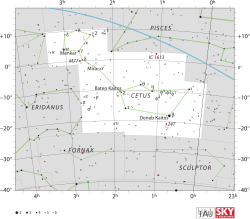Alpha Ceti
| Observation data Epoch J2000 Equinox J2000 | |
|---|---|
| Constellation | Cetus |
| Right ascension | 03h 02m 16.77307s[1] |
| Declination | +04° 05′ 23.0596″[1] |
| Apparent magnitude (V) | 2.53[2] |
| Characteristics | |
| Spectral type | M1.5 IIIa[3] |
| U−B color index | +1.93[2] |
| B−V color index | +1.64[2] |
| Variable type | None[4] |
| Astrometry | |
| Radial velocity (Rv) | –26.08 ± 0.02[5] km/s |
| Proper motion (μ) | RA: -10.41 ± 0.51[1] mas/yr Dec.: -76.85 ± 0.36[1] mas/yr |
| Parallax (π) | 13.09 ± 0.44 mas[1] |
| Distance | 249 ± 8 ly (76 ± 3 pc) |
| Absolute magnitude (MV) | –3.2 ± 0.3[3] |
| Details | |
| Mass | 2.3 ± 0.2[6] M☉ |
| Radius | 89 ± 5[6] R☉ |
| Luminosity | 1455 ± 328[6] L☉ |
| Surface gravity (log g) | 0.9 ± 0.1[6] cgs |
| Temperature | 3,795 ± 70[6] K |
| Metallicity [Fe/H] | 0.00 ± 0.30[6] dex |
| Rotational velocity (v sin i) | 6.9[7] km/s |
| Other designations | |
| Database references | |
| SIMBAD | data |
Alpha Ceti (α Cet, α Ceti) is a star in the constellation of Cetus. It has the traditional name Menkar or Menkab. The name Menkar derives from the Arabic word منخر manħar "nostril" (of Cetus).
This star, along with γ Cet (Kaffaljidhma), δ Cet, λ Cet (Menkar), μ Cet, ξ1 Cet and ξ2 Cet were Al Kaff al Jidhmah, "the Part of a Hand".[8]
In Chinese, 天囷 (Tiān Qūn), meaning Circular Celestial Granary, refers to an asterism consisting of α Ceti, κ1 Ceti, λ Ceti, μ Ceti, ξ1 Ceti, ξ2 Ceti, ν Ceti, γ Ceti, δ Ceti, 75 Ceti, 70 Ceti, 63 Ceti and 66 Ceti. Consequently, α Ceti itself is known as 天囷一 (Tiān Qūn yī, English: the First Star of Circular Celestial Granary.)[9]
Structure
Despite having the Bayer designation α Ceti, at visual magnitude 2.54 this star is actually not the brightest star in the constellation Cetus. That honor goes instead to Beta Ceti at magnitude 2.04. Menkar is a red giant with a stellar classification of M1.5 IIIa. It has more than twice the mass of the Sun and, as a giant star has expanded to about 89 times the Sun's radius. The large area of the photosphere means that it is emitting about 1,455 times as much energy as the Sun, even though the effective temperature is only 3,795 K (compared to 5,778 K on the Sun). The relatively low temperature gives Menkar the red hue of an M-type star.[10]
Menkar has evolved from the main sequence after exhausting the helium at its core. As it begins to burn its carbon core it will probably become a highly unstable star like Mira before finally shedding its outer layers and forming a planetary nebula, leaving a relatively large white dwarf remnant.[11]
Namesakes
USS Menkar (AK-123) was a United States Navy Crater class cargo ship named after the star.
See also
References
- ^ a b c d e van Leeuwen, F. (November 2007). "Validation of the new Hipparcos reduction". Astronomy and Astrophysics. 474 (2): 653–664. arXiv:0708.1752. Bibcode:2007A&A...474..653V. doi:10.1051/0004-6361:20078357.
- ^ a b c Johnson, H. L.; et al. (1966). "UBVRIJKL photometry of the bright stars". Communications of the Lunar and Planetary Laboratory. 4 (99). Bibcode:1966CoLPL...4...99J.
- ^ a b Tsuji, T. (October 2008), "Cool luminous stars: the hybrid nature of their infrared spectra", Astronomy and Astrophysics, 489 (3): 1271–1289, arXiv:0807.4387, Bibcode:2008A&A...489.1271T, doi:10.1051/0004-6361:200809869
- ^ Wittkowski, M.; et al. (November 2007), "Polychromatic Interferometry of Mira Variables", in Kerschbaum, F.; Charbonnel, C.; Wing, R. F. (eds.), Why Galaxies Care About AGB Stars: Their Importance as Actors and Probes, proceedings of the conference held 7-11 August 2006 at University Campus, Vienna, Austria, ASP Conference Series, vol. 378, San Francisco: Astronomical Society of the Pacific, p. 262, Bibcode:2007ASPC..378..262W
- ^ Famaey, B.; et al. (January 2005). "Local kinematics of K and M giants from CORAVEL/Hipparcos/Tycho-2 data. Revisiting the concept of superclusters". Astronomy and Astrophysics. 430 (1): 165–186. arXiv:astro-ph/0409579. Bibcode:2005A&A...430..165F. doi:10.1051/0004-6361:20041272.
- ^ a b c d e f Wittkowski, M.; et al. (December 2006), "Tests of stellar model atmospheres by optical interferometry. IV. VINCI interferometry and UVES spectroscopy of Menkar", Astronomy and Astrophysics, 460 (3): 855–864, arXiv:astro-ph/0610150, Bibcode:2006A&A...460..855W, doi:10.1051/0004-6361:20066032
- ^ Massarotti, Alessandro; et al. (January 2008), "Rotational and Radial Velocities for a Sample of 761 HIPPARCOS Giants and the Role of Binarity", The Astronomical Journal, 135 (1): 209–231, Bibcode:2008AJ....135..209M, doi:10.1088/0004-6256/135/1/209
- ^ Star Name - R.H. Allen p.160
- ^ Template:Zh icon AEEA (Activities of Exhibition and Education in Astronomy) 天文教育資訊網 2006 年 7 月 11 日
- ^ "The Colour of Stars", Australia Telescope, Outreach and Education, Commonwealth Scientific and Industrial Research Organisation, December 21, 2004, retrieved 2012-01-16
- ^ Kaler, James B., "MENKAR (Alpha Ceti)", Stars, University of Illinois, retrieved 2011-12-24

